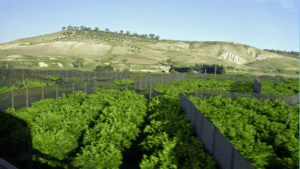Sicily off the southernmost tip of Italy, is the largest island in the Mediterranean and at the centre of the ancient trade routes. The Greeks, Romans, Arabs and Normans have all left their mark on the island.
Much of the centre of the island is mountainous. The eastern part is dominated by Mount Etna which at 3323m is Europe’s biggest active volcano.
A major eruption in 1669 followed by a massive earthquake in 1699 destroyed much of the eastern half of the island resulting in a massive Baroque style rebuilding.
Most of the settlement is around coast with houses and roads climbing up the hillsides. The centre of the island is sparsely populated and is a region of rolling hills and craggy mountains. it is sandstone in the east and limestone in the west. The few inland towns were built on the top of hills and were defensive sites as the island under threat from African pirates until C19th.
Sicily is very fertile. Much of the central area has been deforested and is subject to erosion and mud slides. Main roads run on stilts over long distances, which saves having to build embankments, cuttings and bridges. It also has the advantage that any mud slides can pass beneath.
Wheat is the main crop in the east. Seed is planted in January and harvested in June. The fields are then left dry and barren, giving a desert like feel. Further west, oranges and vines appear. Some of the vines are covered with polythene which slows down development and harvesting can continue until December. The grapes are either used to make wine or sold as table grapes.
Sicily used to be major producer of citrus fruit but now it is cheaper to import fruit from North Africa and much of fruit is unharvested and left to rot on the trees.
Only 11% of the population still work on land and there are many derelict farm buildings. Many of the small peasant farm buildings are used for storage. Most of agricultural workers come from North Africa. Unemployment is a serious problem and can be as high as 70% in some rural areas. This has resulted in a very strong black economy with many people having two jobs but only declaring one.
Over 50% of the energy is supplied by wind power and the turbines can be seen on top of many hills. The government is trying to increase use of solar power and in places there are fields of solar panels. Subsidies are available, but apparently the government is very slow to pay up. Sicily does have some oil which can supply 10% of national needs but it is poor quality with a lot of sulphur.
I spent eight days in Sicily on a guided tour with Riviera Travel. My full report is “here.”:http://wasleys.org.uk/eleanor/otherholidays/sicily/index.html It was very much a whistle stop tour hitting the highlights. I enjoyed what I saw and wished I’d had longer. Many pictures were taken through the coach window which explains the poorer quality.














